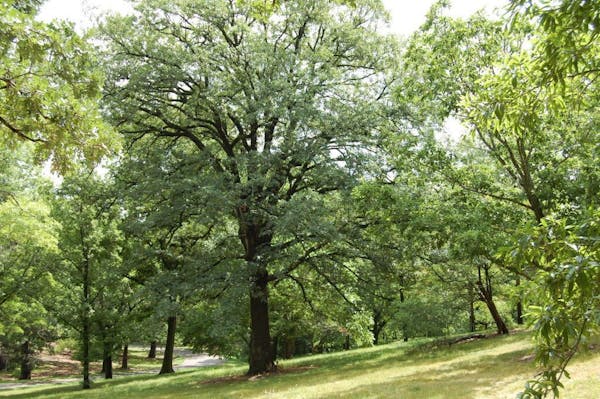Here are Alan Branhagen's top 10 native plants. (You can see them at the Minnesota Landscape Arboretum.)
1. Shade tree: white oak (Quercus alba). A very long-lived, statuesque tree with sturdy, broad-spreading limbs. It looks great in all seasons, and fall colors run from red to even purplish-red. The tree is superior for wildlife, especially migrating songbirds. One of the coolest around is beside the Wilson Rose Garden.
2. Evergreen tree: Eastern white pine (Pinus strobus). Another long-lived and statuesque tree the lumber of which helped build the Midwest. The soft needles create a soothing sound in the breeze and drop each fall. The cones attract wildlife and songbirds.
3. Small tree: pagoda dogwood (Cornus alternifolia). The tiered "sympodial" branching looks great all winter, and its late-spring clusters of creamy white flowers attract pollinators. The fruits ripen purplish-black in late summer and attract a wide array of songbirds. Its fall color is also outstanding, with golden to burnt orange with burgundy tones.
4. Shrub: black chokeberry (Aronia melanocarpa). An edible landscape plant with somewhat bitter fruits, they nonetheless make great preserves and are rich in antioxidants. The spring flowers are white, foliage is lustrous green and fall color can be in wonderful shades of red. The inky black berries are especially pretty in the fall; they freeze-dry and last into winter.
5. Vine: Virginia creeper (Parthenocissus quinquefolia). A great plant for creating a living wall, whether on a fence or brick building. The lustrous foliage has secret blooms that are abuzz with pollinators. Fall color can be a dazzling red. Fall fruits are purplish on red stems and are food for migrating songbirds.
6. Prairie perennial: meadow blazingstar (Liatris ligulistylis). This perennial blooms around Labor Day and is always covered with pollinators, including butterflies. It's a favorite refueling plant for migrating monarchs. The seeds mature into wonderful tufts in the fall.
7. Woodland perennial: sharp-lobed hepatica (Hepatica/Anemone acutiloba). One of our harbingers of spring in the woodlands, flowers can be white, pink or blue shades. The three-parted "liver-shaped" foliage is evergreen; some plants have mottled leaves.
8. Wetland perennial: swamp milkweed (Asclepias incarnata). A great plant for a long season of blooming in pink and white with a candy-corn-like fragrance, which attracts a myriad of pollinators.
9. Ground cover: Pennsylvania sedge (Carex pennsylvanica). Here's a great substitute for turf in shade or even full sun in well-drained soil. It spreads to look like turf and needs mowing only in early spring before new growth. Seeds are good for songbirds.
10. Annual: partridge pea (Chamaecrista fasciculata). A wonderful summer annual with bright yellow flowers pollinated by bees creating quite a sight and buzzing sound. The seeds are elongated pea pods that explode in autumn when dry.
Want to learn more ?
Try these local resources:
• Wild Ones Native Plants, Natural Landscapes. wildones.org.
• Minnesota Native Plant Society, mnnps.org.
• Minnesota Landscape Arboretum, arboretum.umn.edu. The arboretum's native habitats include Spring Peeper Meadow, Dayton Wildflower Garden, Bennett-Johnson Prairie and Garden for Wildlife.
Get better sleep with these 5 tips from experts

Ex-gang leader's account of Tupac Shakur killing is fiction, defense lawyer in Vegas says
Movie Review: Prepare to get hot and bothered with stylish, synthy tennis drama 'Challengers'
Crew members injured in crash on Georgia set of Eddie Murphy Amazon MGM movie 'The Pickup'

